UMass Extension's Landscape Message is an educational newsletter intended to inform and guide Massachusetts land care professionals in the management of our collective landscape. Detailed reports from scouts and Extension specialists on growing conditions, pest activity, and cultural practices for the management of woody ornamentals, trees, and turf are regular features. The following issue has been updated to provide timely management information and the latest regional news and environmental data.
Welcome to Landscape Message #13 for the 2024 growing season. We are now in the bi-weekly phase of the annual schedule, and the next message will be posted July 26. To receive immediate notification when the next Landscape Message update is posted, be sure to join our e-mail list
Click on the headings below to jump to that section of the message.
In This Issue
Scouting Information by Region
Woody Ornamentals
Scouting Information by Region
Environmental Data
The following data was collected on or about July 10, 2024. Total accumulated growing degree days (GDD) represent the heating units above a 50ºF baseline temperature collected via regional NEWA stations (http://newa.cornell.edu) for the 2024 calendar year. This information is intended for use as a guide for monitoring the developmental stages of pests in your location and planning management strategies accordingly.
|
MA Region/Location |
2024 Growing Degree Days |
Soil Temp |
Precipitation |
Time/Date of Readings |
||
| Gain since last report |
2024 total |
Sun |
Shade |
|||
|
CAPE |
305 |
1021 |
75 |
71 |
1.54 |
12:00 PM 7/10/2024 |
|
SOUTHEAST |
344 |
1225 |
83 |
73 |
1.33 |
3:00 PM 7/10/2024 |
|
NORTH SHORE |
331 |
1088 |
75 |
69 |
0.97 |
10:00 AM 7/10/2024 |
|
EAST |
355 |
1253 |
81 |
71 |
2.31 |
4:00 PM 7/10/2024 |
|
METRO |
351 |
1201 |
74 |
69 |
1.29 |
5:45 AM 7/10/2024 |
|
CENTRAL |
336 |
1212 |
74 |
70 |
1.22 |
11:00 AM 7/10/2024 |
|
PIONEER VALLEY |
326 |
1261 |
78 |
72 |
2.85 |
1:00 PM 7/10/2024 |
|
BERKSHIRES |
288 |
1095 |
79 |
71 |
0.93 |
6:00 AM 7/10/2024 |
|
AVERAGE |
330 |
1170 |
77 |
71 |
1.56 |
- |
|
n/a = information not available |
||||||
US Drought Monitor: At this time, the vast majority of Berkshire County, the western half of both Franklin and Hampshire Counties, the northern 2/3 of Essex County and and a small portion of northern Middlesex County are classified as "D0 - Abnormally Dry" (about 27% of the state's area in total; an increase from the last message). State map as of Thursday 7/11: https://droughtmonitor.unl.edu/CurrentMap/StateDroughtMonitor.aspx?MA
Phenology
| Indicator Plants - Stages of Flowering (BEGIN, BEGIN/FULL, FULL, FULL/END, END) | ||||||||
|---|---|---|---|---|---|---|---|---|
| PLANT NAME (Botanic / Common) | CAPE | S.E. | N.S. | EAST | METRO W. | CENT. | P.V. | BERK. |
|
Hibiscus syriacus (rose-of-Sharon) |
* |
Begin |
* | * |
* |
* |
Begin/Full |
* |
|
Buddleia davidii (butterfly bush) |
* |
* |
Full |
Full |
Full |
Begin/Full |
Begin/Full |
Begin/Full |
|
Lythrum salicaria (loosestrife) |
* |
Begin |
Full |
Full |
Full |
Full |
Full |
* |
|
Campsis radicans (trumpet vine) |
* |
Full |
Full |
Full |
Full |
Full |
Full |
|
|
Koelreuteria paniculata (goldenrain tree) |
* |
Full |
Full/End |
Full |
* |
Begin |
Full |
|
|
Hydrangea paniculata (panicle hydrangea) |
* |
Begin |
Begin |
Begin/Full |
Begin/Full |
Begin |
Begin |
Begin/Full |
|
Hydrangea macrophylla (bigleaf hydrangea) |
* |
Full/End |
Full |
Full |
Full |
Begin/Full |
Full |
Full |
| * = no activity to report/information not available | ||||||||
Regional Notes
Cape Cod Region (Barnstable)
General Conditions:
The average temperature for the period from June 26 thru July 10 was 71ºF with a high of 86ºF on July 7 and a low of 51ºF on June 28. An inch and a half of precipitation fell in Barnstable, primarily on June 27 and June 30.
Pests/Problems:
Not available this week.
Southeast Region (Dighton)
General Conditions:
Over the past two weeks, the region has experienced an extended period of intense heat and humidity, which has led to the issuance of dangerous weather warnings and heat stress advisories. These weather conditions are forecast to persist for at least another week before any significant relief is expected. The highest temperature was 89ºF on Saturday, July 6th, while the lowest was 57ºF on the morning of Friday, June 28th. The average temperature over the past two weeks was 73ºF. Total precipitation measured 1.33 inches, primarily occurring overnight on Thursday, June 27th. The average humidity was 80%. The highest wind speed was 16 mph from the south-southeast on Saturday, June 29th. Furthermore, soil temperatures were 83ºF in full sun and 73ºF in shade at 3:00 PM on Wednesday, July 10th.
Among the many plants in flower are: Campsis radicans (trumpet vine), Cotinus coggygria (common smokebush), Hibiscus syriacus (rose-of-Sharon), Hydrangea arborescens (smooth hydrangea), Hydrangea macrophylla (bigleaf hydrangea), Hydrangea paniculata (panicle hydrangea), Koelreuteria paniculata (goldenrain tree), Ligustrum spp. (privet), Lythrum salicaria (loosestrife), Rhus typhina (staghorn sumac), and Sambucus canadensis (American elderberry).
Pests/Problems:
Both Asiatic garden beetle and Oriental beetle adults have emerged. Yellow nutsedge is at +3 leaves. Fall webworm has been observed on elm and crabapple. Additionally, mosquitoes trapped in Carver have tested positive for Eastern Equine Encephalitis (Triple E). Arboviruses accumulate in mosquito populations as they feed, and it is concerning that infected mosquitoes have been recovered so early in the season.
North Shore (Beverly)
General Conditions:
The last two weeks were hot and humid. Daytime temperatures were in the mid to high 80s and nighttime temperatures were mostly in the low 60s to low 70s. A temperature of 90ºF was recorded only on Sunday, July 7. The average daily temperature was 74ºF with a minimum temperature of 55ºF recorded on June 28 and a maximum temperature of 90ºF recorded on July 7. There were some scattered rain showers during the weeks of this reporting period. Approximately 0.97 inch of rainfall was received at Long Hill, Beverly during this reporting period.
Because of the rain and warm temperatures, turf on lawns is growing fast and requires regular mowing.
Woody plants seen in bloom include mountain stewartia (Stewartia ovata), mimosa (Albizia julibrissin), oakleaf hydrangea (Hydrangea quercifolia), bigleaf hydrangea (Hydrangea macrophylla), cut-leaf chaste tree (Vitex negundo), golden rain tree (Koelreuteria paniculata), smooth leaf hydrangea (Hydrangea arborescens), and summer blooming spirea (Spiraea japonica). Herbaceous plants seen in bloom include: summer flowering roses (Rosa sp.), clematis vines (Clematis paniculata), spiderwort (Tradescantia sp.), water lily (Nymphaea odorata), hardy cranesbill (Geranium sp.), ox-eye daisy (Leucanthemum vulgare), bee balm (Monarda didyma), hosta (Hosta sp.), rudbeckia (Rudbeckia fulgida), daylilies (Hemerocallis sp.), astilbes (Astilbe sp.), coneflower (Echinacea purpurea), milkweed (Asclepias syriaca), and yarrow (Achillea millefolium). Many annuals are also adding color to the landscape.
Pests/Problems:

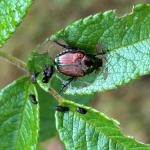 Adult Japanese beetles were observed causing serious damage on rose bushes.
Adult Japanese beetles were observed causing serious damage on rose bushes.
Powdery mildew was observed on garden phlox.
Cedar-apple rust was observed on crabapples.
Weeds continue to thrive in the landscape. Control weeds before they set seed. Poison ivy is also thriving so take caution when walking or working in the woods.
Remember also that ticks and mosquitoes are still very active. Take measures to protect yourself while working outdoors, especially at dawn or at dusk.
East (Boston)
General Conditions:
We have been under a heat advisory since July 8. It has been uncomfortably hazy, hot and humid for the past several days. Daytime temperatures over the past two weeks averaged 84ºF, with temperatures in the 90’s July 7 through 9. Overnight lows averaged 66ºF with a low of 54ºF on June 28th. June ended with a total of 3.02 inches of precipitation. We have received 0.59 inches to this point in July. We have reached 1218 GDD’s (base 50). The landscape continues to be lush with plant growth. Some plants in bloom include; Daucus carota (Queen Anne’s lace), Hydrangea quercifolia (oakleaf hydrangea), Hypericum spp. (St. John’s-wort), Koelreuteria paniculata (golden rain tree), Stewartia pseudocamellia (Japanese stewartia), and Yucca filamentosa (Adams needle yucca).
Pests/Problems:
Powdery mildew is prevalent on Monarda spp. (bee balm).
Canada thistle (Cirsium arvense) is flowering. Black swallow-wort (Cynanchum louiseae) continues to flower and is forming seed pods. Yellow nutsedge (Cyperus esculentus) is flowering.
Metro West (Acton)
General Conditions:
Summer is here, and we have the heat to prove it. We’ve now experienced our second heat wave of the season during this last two-week reporting period beginning on July 7th and continuing through to the 9th with high temperatures recorded at 91ºF, 93ºF, and 91ºF respectively. Thankfully, there has been some amount of precipitation recorded on 9 out of the past 14 days, albeit scant, but better than nothing! For June, the historical monthly average precipitation is 3.93”, and 2.69” of rain was recorded. For July, the historical monthly average precipitation is 3.43” and as of the 9th, 0.97” of rain has been recorded for the month so far.
The landscape is lush and colorful with all that is in some stage of bloom including the following plants: Aesculus parviflora (bottlebrush buckeye), Campsis radicans (trumpet vine), Hydrangea paniculata (panicle hydrangea), Daucus carota (Queen Anne's lace), Echinacea purpurea (coneflower), Liatris spicata (spike gayfeather), Lysimachia clethroides (gooseneck loosestrife), Platycodon grandiflorus (balloon flower), and Rudbeckia fulgida var. sullivantii 'Goldsturm' (black-eyed Susan).
Pests/Problems: Ailanthus altissima (tree of heaven), an invasive tree, has set seed and is now highly visible and showy because its seeds (samaras) are chartreuse in color, are plentiful, and grow in clusters.
Central Region (Boylston)
General Conditions:
Into the thicket of summer, temperatures continue to rise, with temperatures averaging 85.4ºF (highest being 95.4ºF on July 7th). Max precipitation was 0.47 inches on June 27th. Occasional rain/thunderstorms unfortunately do not seem to be enough to keep soil saturated due to the extreme heat.
Some plants that can be seen blooming currently are hydrangeas (Hydrangea spp.), bottlebrush buckeye (Aesculus parviflora), coneflower (Echinacea spp.), daylily (Hemerocallis spp.), and wild bergamot (Monarda spp.).
Pests/Problems:
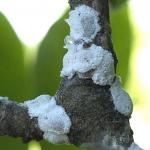
 A prominent pest that can be seen in the landscape is magnolia scale, which is found mostly in cultivated spaces. These trees were previously treated last year, and mostly likely will continue to be treated.
A prominent pest that can be seen in the landscape is magnolia scale, which is found mostly in cultivated spaces. These trees were previously treated last year, and mostly likely will continue to be treated.
Lastly, one problem that tends to stick out is the extreme heat and dry weather. Plants that have been planted and established in the ground for years seem to be dying back, from Helianthus spp. to Kalmia.
Pioneer Valley (Amherst)
General Conditions:
With Independence Day now behind us, we’ve settled into the dog days of summer. Conditions in the Pioneer Valley are feeling very similar to last year at this time, with a steady supply of heat, high humidity, and scattered (sometimes heavy) showers. The patchy development of these storms means some areas have been flush with rainfall while others could use a bit more. Since our last report, precipitation totals have ranged from 1.5–3” in Hampden County, 1.25–4” in Hampshire County, and 2–5” in Franklin County.
The strong plant growth this season combined with the rain and winds means some plants are leaning and flopping all over the garden. There’s an abundance of pollinator activity across the landscape and a variety of perennials are in full bloom. Soil moisture is generally good depending on the specific location, but closely monitor new transplants given the high heat. While the current season’s growth on woody plants is mostly hardened off, transpirational water loss for cooling can sap a significant percentage of daily water usage.
Pests/Problems:
Annual fruiting bodies of the fungal wood-rotting pathogen Niveoporofomes spraguei are forming at the base of infected oaks. Powdery mildew on dogwood is readily visible at present. Symptoms include reddening, white powdery masses, and leaf distortion. Any time of year is a good time to prune blighted stems and small branches from tree and shrub canopies. Opportunistic cankering pathogens are common and destructive on stressed and weakened hosts.
Insect activity and feeding remains high right now. At times, sporadic leaf chewing and defoliation is hard to assign to a particular pest, given the diverse array of insects along with slugs and earwigs (among others). Hemlock woolly adelgid (Adelges tsugae) populations are high this season due to the mild winter. Invasive scarab beetles (Asiatic, Oriental and Japanese) are locally abundant and causing damage on a variety of herbaceous and woody plants. Leaf notching from vine weevils has been observed on rhododendrons. Hibiscus sawfly (Atomacera decepta) injury is high on untreated plants.
Berkshire Region (West Stockbridge)
General Conditions: Hazy, hot, and humid best characterize the weather conditions of the past two weeks, often making working conditions barely tolerable. For the most part, a lack of steady breeze also contributed to difficult conditions. Of course, with the diverse terrain characteristic of the Berkshires, temperatures and rainfall varied with location. At the 3 NEWA sites, the highest daily temperatures for the scouting period were: 90ºF in Richmond on July 7, 88ºF in North Adams on July 6 and 8, and 87ºF in Pittsfield on July 6, 8, and 9. The lowest temperatures at these sites all occurred on July 3, the day before the heat moved in. On that day, Richmond and Pittsfield recorded a low of 55ºF, and North Adams had a low of 57ºF. The heaviest rainfall for the two-week period occurred on July 6, along with some high winds which caused some power outages. Again, the intensity of the storm varied with location. Rainfall totals for the two weeks were: 1.96 inches in Pittsfield, 1.11 inches in Richmond, 1.10 inches in North Adams, and 0.93 inches at this site in West Stockbridge.
Soil moisture varied over the period as soil quickly dried on hot, sunny days, then recovered briefly following a rain, only to return to low moisture levels. Still, turfgrass has not yet shown signs of stress and growth has progressed with mowing schedules for lawns pretty much unchanged. The blooming of many herbaceous perennials and flowering woody plants has been a bit ahead this season, but the period of bloom does not seem to be affected by the heat, at least up to this point. Weeds certainly have not been affected as they are growing fast and are a prime focus of garden and landscape caretakers.
Pests/Problems:
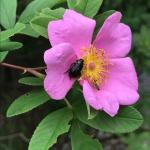
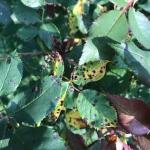

 The appearance of Japanese beetles has been right on time, though the numbers currently are not great. Still, skeletonized leaves can be seen on some plants, especially roses, a prime target for Japanese beetles. Asiatic garden beetles are also actively feeding on roses.
The appearance of Japanese beetles has been right on time, though the numbers currently are not great. Still, skeletonized leaves can be seen on some plants, especially roses, a prime target for Japanese beetles. Asiatic garden beetles are also actively feeding on roses.
Other insect pests observed are adult elongated hemlock scale, four-lined plant bug, magnolia scale, aphids, and spruce spider mite.
Among the diseases detected were powdery mildew on a variety of herbaceous annuals and perennials, and leaf blotch (Didymosphaeria petrakiana) on little leaf linden (Tilia cordata). Black spot disease has caused much defoliation on rose bushes. Cedar apple rust has been observed on crabapple since the plants leafed out and now many of those infected trees have shed considerable leaves. Another rust, quince rust, was found on both crabapples and hawthorn (Crataegus viridis).
Regional Scouting Credits
- CAPE COD REGION - Russell Norton, Horticulture and Agriculture Educator with Cape Cod Cooperative Extension, reporting from Barnstable.
- SOUTHEAST REGION - Brian McMahon, Arborist, reporting from the Dighton area.
- NORTH SHORE REGION - Geoffrey Njue, Green Industry Specialist, UMass Extension, reporting from the Long Hill Reservation, Beverly.
- EAST REGION - Kit Ganshaw & Sue Pfeiffer, Horticulturists reporting from the Boston area.
- METRO WEST REGION – Julie Coop, Forester, Massachusetts Department of Conservation & Recreation, reporting from Acton.
- CENTRAL REGION - Mark Richardson, Director of Horticulture, and Anna Petrie, reporting from New England Botanic Garden at Tower Hill, Boylston.
- PIONEER VALLEY REGION - Nick Brazee, Plant Pathologist, UMass Extension Plant Diagnostic Lab, reporting from Amherst.
- BERKSHIRE REGION - Ron Kujawski, Horticultural Consultant, reporting from Great Barrington.
Woody Ornamentals
Diseases
Recent pests, pathogens, or problems of interest seen in the UMass Extension Plant Diagnostic Lab, a select few:
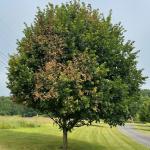
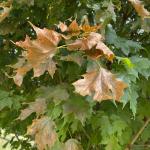 Verticillium wilt, caused by Verticillium dahliae, on sugar maple (Acer saccharum) and staghorn sumac (Rhus typhina ‘Tiger Eye’). The sugar maple is approximately 8-10” in diameter and 25-30’ tall. It is one of eight trees spaced widely on opposite sides of a long, residential driveway. The trees were established 11 years ago and reside in full sun surrounded by turf with no supplemental irrigation. In early June, the foliage on two trees began to develop a diffuse browning on scattered branches throughout the canopy. Small, cross-sectional discs were cut from the submitted branch segments and incubated for several days. From these discs, verticillate fungal mycelia (produced in whorls around a central thread) and microsclerotia were produced. Microsclerotia are microscopic, seed-like structures that form in diseased leaves, branches, and roots. When they become incorporated into the organic layer and soil, the fungus can persist at the site for several years. Overland spread of the diseased foliage is a primary means of pathogen dispersal. The sumac is roughly 15 years old and has been present at the site (a botanical garden) for 13 years. It resides on a sunny hillside in well-drained loam soils with drip irrigation. Earlier this summer, wilting and collapse of the new shoots was observed. The submitted branch segments had blackened cankers and vascular staining that was deep in the xylem. In addition to Verticillium, the opportunistic cankering pathogen Phomopsis was also present.
Verticillium wilt, caused by Verticillium dahliae, on sugar maple (Acer saccharum) and staghorn sumac (Rhus typhina ‘Tiger Eye’). The sugar maple is approximately 8-10” in diameter and 25-30’ tall. It is one of eight trees spaced widely on opposite sides of a long, residential driveway. The trees were established 11 years ago and reside in full sun surrounded by turf with no supplemental irrigation. In early June, the foliage on two trees began to develop a diffuse browning on scattered branches throughout the canopy. Small, cross-sectional discs were cut from the submitted branch segments and incubated for several days. From these discs, verticillate fungal mycelia (produced in whorls around a central thread) and microsclerotia were produced. Microsclerotia are microscopic, seed-like structures that form in diseased leaves, branches, and roots. When they become incorporated into the organic layer and soil, the fungus can persist at the site for several years. Overland spread of the diseased foliage is a primary means of pathogen dispersal. The sumac is roughly 15 years old and has been present at the site (a botanical garden) for 13 years. It resides on a sunny hillside in well-drained loam soils with drip irrigation. Earlier this summer, wilting and collapse of the new shoots was observed. The submitted branch segments had blackened cankers and vascular staining that was deep in the xylem. In addition to Verticillium, the opportunistic cankering pathogen Phomopsis was also present.
Anthracnose caused by Colletotrichum on red maple (Acer rubrum), bayberry (Morella pensylvanica), flowering dogwood (Cornus florida ‘Appalachian Spring’), eastern hemlock (Tsuga canadensis), and shagbark hickory (Carya ovata). Plants of various ages at differing properties throughout the region. The flowering dogwood is <10 years old and was planted seven years ago along with several other dogwoods at a residential property. The roadside setting experiences half sun with good loam soils. For several years, the foliage has developed blackened, interveinal blotches near the margins. Foliar sprays of copper have done little to control the onset of symptoms. This is not how anthracnose symptoms typically manifest so additional case history information revealed the tree is subjected to de-icing salts during the winter. Therefore, salt injury is suspected as the primary cause of symptoms with Colletotrichum causing additional dieback. The hemlock is mature (~50 years old) and resides in a shaded, residential landscape. The submitted shoots had new growth that was extremely stunted along with blighted twigs. While far less common on conifers, Colletotrichum has a broad host range and can regularly infect needled evergreens. The red maple and bayberry are <10 years old and were transplanted onto the same property two years ago. In early June, they experienced scattered leaf browning and dieback in the canopy. These plants reside in full sun and are watered via overhead irrigation. In addition to a foliar blight, the pathogen also caused stem cankers on both plants. Depending on the host and setting, Colletotrichum is also capable of attacking woody tissues. However, the fungus cannot attack roots and with good cultural control (and sometimes chemical intervention), it can be successfully managed.
Phytoplasma infection of Midwinter Fire bloodtwig dogwood (Cornus sanguinea ‘Midwinter Fire’). About 100 plants of this cultivar were planted at four properties over several years. The nursery stock originated from four different nurseries in the region. Disease symptoms are present on numerous plants at each property but occur only on plants established more than five years ago. At one property, 12/36 plants were symptomatic. Symptoms include witches’ brooming (dense, tufted growth) along with leaf curling/distortion, yellowing and subsequently an overall canopy thinning and stem dieback. The symptoms first developed in 2022 and have appeared annually since. Symptomatic material from all four properties was tested using PCR, which confirmed a phytoplasma is present. The testing does not determine a specific phytoplasma. This group of bacteria (mollicutes) are particularly challenging to work with because they cannot be cultured and have not been formally described. Many have broad and overlapping host ranges among herbaceous and woody plants. They are vectored by a range of sap feeding insects, such as spittlebugs and leafhoppers, which themselves are difficult to impractical to control. Aster yellows is known to occur on gray dogwood (C. racemosa) in North America, but little is known about the susceptibility of dogwoods to phytoplasmas.
Report by Nick Brazee, Plant Pathologist, UMass Extension Plant Diagnostic Lab, UMass Amherst
Insects and Other Arthropods
The Professional Insect and Mite Management Guide for Woody Plants is freely available at https://ag.umass.edu/insectmiteguide. Please let me know how it is or isn’t working for you by responding to the following Feedback Form: Professional Insect & Mite Management Guide for Woody Plants. Your feedback is valuable and I cannot wait to hear from you!
Note: Our website is undergoing updates, and as such, the collapsible menus on the home page of the Guide are currently not functioning. Thank you for your patience as we await these updates.
Invasive Updates:
- Asian Longhorned Beetle is still present in Worcester, Shrewsbury, Boylston, West Boylston, and parts of Holden and Auburn, MA. If you suspect you’ve found this insect or the damage it causes, please report it to the Asian Longhorned Beetle Eradication Program office in Worcester, MA at 508-852-8090 or toll free at 1-866-702-9938.
Now is the time to monitor for adult Asian longhorned beetles! Emergence typically begins in July in Massachusetts while the presence of common look-alikes (such as the white spotted pine sawyer) is nearing an end for the growing season. When in doubt about the identity of a longhorned beetle, always report it.
To report an Asian longhorned beetle find online or to compare it to common insect look-alikes, visit: http://massnrc.org/pests/albreport.aspx
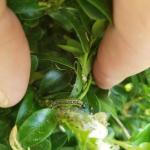

 Box Tree Moth has been detected in the following Massachusetts communities: Bourne, Sandwich, and Barnstable. A map of these locations is available at MDAR’s Invasive Pest Dashboard. If you believe you have found this insect, please take a photo, note your location, and report it immediately to the MA Department of Agricultural Resources using their Report a Pest Form. Box tree moth caterpillars were reported to be active at certain locations on Cape Cod, MA as of the week of April 19th. C.L. Fornari reports on 6/8/2024 that box tree moth pupae are present at a location in Sandwich, MA at this time (see photos). These pupae are likely the overwintered caterpillars that were actively feeding in April which will give rise to the next generation of adults.
Box Tree Moth has been detected in the following Massachusetts communities: Bourne, Sandwich, and Barnstable. A map of these locations is available at MDAR’s Invasive Pest Dashboard. If you believe you have found this insect, please take a photo, note your location, and report it immediately to the MA Department of Agricultural Resources using their Report a Pest Form. Box tree moth caterpillars were reported to be active at certain locations on Cape Cod, MA as of the week of April 19th. C.L. Fornari reports on 6/8/2024 that box tree moth pupae are present at a location in Sandwich, MA at this time (see photos). These pupae are likely the overwintered caterpillars that were actively feeding in April which will give rise to the next generation of adults.
Adult box tree moths have been reported arriving at blacklight traps on Cape Cod, MA as of 6/24/2024 and by others monitoring the same area the week prior.
The USDA APHIS has announced a new quarantine for box tree moth in Massachusetts and Ohio, and has expanded existing quarantines in Michigan and New York. This includes conditions for interstate movement of regulated Buxus species. This quarantine includes the entire Commonwealth of Massachusetts. The federal order states:
“Boxwood plants may only be moved interstate from a quarantined area from an establishment operating under a compliance agreement, and only if accompanied by a certificate issued by a State Agricultural Authority certifying that the requirements of this Federal Order and the compliance agreement have been met. These requirements will prevent producers and distributors of boxwood from moving infested plants interstate. State Agricultural Authorities may prescribe additional safeguards and protocols.
All other regulated articles of boxwood, including plant parts, pieces, cuttings, clippings, debris, and any portion of the plant, alive or dead, except for decorative purposes, are prohibited from movement.”
MDAR has recently sent a notice to boxwood growers in Massachusetts of the following:
"Effective May 22, 2024, the USDA has issued a Federal Order establishing a quarantine for the entire state of Massachusetts. In an effort to restrict the movement of box tree moth, boxwoods (Buxus spp.) may no longer be exported from Massachusetts except by an establishment operating under a compliance agreement (CA) to be issued by MDAR. Anyone wishing to register for a CA must go to the Massachusetts Department of Agricultural Resources box tree moth page and click on the EXPORTS link, and fill out the form. An MDAR staff person will follow up within one week. Please note that the quarantine does NOT restrict in-state sales, movement within the state, or import of boxwoods into Massachusetts. If you have any further questions, please feel free to contact either MDAR (taryn.lascola@mass.gov) or USDA (203-741-5641)."
To read the full announcement of the box tree moth quarantine for Massachusetts from MDAR, please visit the Massachusetts Introduced Pests Outreach Blog.
Need information about monitoring and trapping box tree moth? Check out this newly available Box Tree Moth Monitoring & Trapping fact sheet from UMass Extension.

 Elm Zigzag Sawfly has been detected in the following Massachusetts communities: Becket, Chester, Windsor, and Williamstown. If you believe you have found this insect, please take a photo, note your location, and report it immediately using MA DCR’s Massachusetts Elm Zigzag Sawfly Reporting Form. Felicia Hubacz, MA DCR, reports elm zigzag sawfly larvae actively feeding in the Becket, MA population as of 5/28/2024. UMass Extension observed tiny elm zigzag sawfly feeding in the Windsor, MA population on 5/31/2024 (see photos).
Elm Zigzag Sawfly has been detected in the following Massachusetts communities: Becket, Chester, Windsor, and Williamstown. If you believe you have found this insect, please take a photo, note your location, and report it immediately using MA DCR’s Massachusetts Elm Zigzag Sawfly Reporting Form. Felicia Hubacz, MA DCR, reports elm zigzag sawfly larvae actively feeding in the Becket, MA population as of 5/28/2024. UMass Extension observed tiny elm zigzag sawfly feeding in the Windsor, MA population on 5/31/2024 (see photos).
Now is the time to search for elm zigzag sawfly larvae actively feeding on their host plants! Please report any suspicious defoliation of elm to the previous reporting link.
- Emerald Ash Borer is well established across most of Massachusetts. A map of these locations from the MA Department of Conservation and Recreation is available.

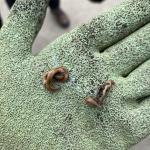 Hammerhead Worms: Also known as flatworms or land planarians, belong to Phylum Platyhelminthes (flat worms) rather than Arthropoda (arthropods) which makes them different from insects and their relatives. Class Insecta is the taxonomic classification of the Insects, whereas hammerhead worms belong to Class Turbellaria. A few common species of non-native hammerhead worms noted in New England include but are not limited to: Bipalium kewense, Bipalium adventitium, and Bipalium pensylvanicum. For more information, see this article in Hort Notes on Hammerhead Worms in New England.
Hammerhead Worms: Also known as flatworms or land planarians, belong to Phylum Platyhelminthes (flat worms) rather than Arthropoda (arthropods) which makes them different from insects and their relatives. Class Insecta is the taxonomic classification of the Insects, whereas hammerhead worms belong to Class Turbellaria. A few common species of non-native hammerhead worms noted in New England include but are not limited to: Bipalium kewense, Bipalium adventitium, and Bipalium pensylvanicum. For more information, see this article in Hort Notes on Hammerhead Worms in New England.
Sightings of these organisms have increased in recent years, possibly due to warming winters and wet summers. Hammerhead worms are predators that prefer to feed on earthworms; however, depending upon the species involved, they may not be an effective predator of certain species of jumping worms. Again in 2024, reports of hammerhead worms have come from parts of Massachusetts (in this case, Martha’s Vineyard; see photos) with questions about safety. Hammerhead worms are known to produce a neurotoxin (tetrodotoxin) which they use in self-defense and to subdue prey. Luckily, hammerhead worms do not produce enough tetrodotoxin to be lethal to humans, but if the neurotoxin comes into contact with exposed skin, irritation may occur. It is advised that handling hammerhead worms should be avoided, and hands or exposed skin be washed with soap and water following any accidental contact.- Jumping Worms are non-native earthworms that impact natural ecosystems. Available resources include a fact sheet about earthworms in Massachusetts and jumping worm FAQ’s.
- Spotted Lanternfly now has established populations in the following locations in Massachusetts: Holyoke, Springfield, West Springfield, Agawam, Fitchburg, Worcester, Shrewsbury, Southborough, Ashland, Wellesley, Weston, Chelmsford, Grafton, and Lawrence, MA. The MA Department of Agricultural Resources reported that spotted lanternfly egg hatch had begun in Holyoke and Springfield, MA as of 5/14/2024.
At this point in the growing season, the life stage of spotted lanternfly that is active are the nymphs (immatures). Spotted lanternfly nymphs are black with white spots (instars 1-3) and change their color to include red patches (instar 4) with the black base with white spots just before maturing into adults. Fourth instar nymphs may not be present until sometime in July.
In areas of the state where spotted lanterfly is present and has been observed through monitoring, the SLF Management Guide suggests management options for SLF nymphs. Spotted lanternfly should not be managed using insecticides in locations where the insect has not been confirmed in the state. This may result in unnecessary, costly, and environmentally irresponsible applications. The first step in areas outside of the communities listed above for MA is to report SLF to MDAR (also see link below).
UMass Extension has received reports of suspicious insects that were thought to be adult spotted lanternflies. Adult SLF may not be present in established populations in MA until late July. Right now, we suspect that the suspicious insects that were seen were adult SLF lookalikes, such as some of the tiger moths or underwing moths. The MA Department of Agricultural Resources provides a great spotted lanternfly look-alike sheet for the nymph and adult life stages.
If you believe you have found this insect, please take a photo, note your location, and report it immediately using the Spotted Lanternfly Report Form. Available resources include a map of spotted lanternfly locations in Massachusetts from the MA Department of Agricultural Resources, MDAR’s spotted lanternfly fact sheet, UMass Extension’s Spotted Lanternfly Management Guide, and an SLF InsectXaminer episode.
Medically Important Pests:
- Ticks are a serious public health concern and may be active in managed landscapes any time temperatures are above freezing. Encounters with deer ticks can increase in New England in April, October, and November; however, precautions should be taken year-round to prevent tick bite exposure. Available resources include tick information from Cape Cod Cooperative Extension, personal protective measures, and a list of potential tick testing resources. The New England Center of Excellence in Vector-Borne Diseases (NEWVEC) also provides the latest tick information and resources.
- Mosquitoes and the diseases they vector are also a serious public health concern in Massachusetts by summer. Available resources include Mosquito Repellents from the Department of Public Health and Prevent Mosquito Bites from the Centers for Disease Control and Prevention. The Massachusetts Department of Public Health tests for Eastern Equine Encephalitis (EEE) and West Nile Virus (WNV) from June to October. The Massachusetts risk maps are currently available for both EEE and WNV. As of July 1st, EEE has been detected in mosquito samples taken from Carver, MA. The MA Department of Public Health now ranks Carver and surrounding communities at moderate risk (meaning there is EEE in mosquito populations in that area now). On June 25th, WNV was found in mosquito samples taken from Quincy, MA. The MA Department of Public Health ranks all of Massachusetts as low risk for WNV (meaning that they consider infection with WNV unlikely as of 7/9/2024).
- Wasps/Hornets: Many wasps are predators of other arthropods, including pest insects such as certain caterpillars that feed on trees and shrubs. Adult wasps hunt prey and bring it back to their nest where young are being reared as food for the immature wasps. A common such example are the paper wasps (Polistes spp.) who rear their young on chewed up insects. Paper wasps can sting, and will defend their nests, which are open-celled paper nests that are not covered with a papery “envelope”. These open-celled nests may be seen hanging from eaves or other outdoor building structures. Aerial yellow jackets and hornets create large aerial nests that are covered with a papery shell or “envelope”. Common yellow jacket species include those in the genus Vespula. Dolichovespula maculata is commonly known as the baldfaced hornet, although it is not a true hornet. The European hornet (Vespa crabro) is three times the size of a yellow jacket and may be confused for the northern giant hornet (Vespa mandarinia). The European hornet is known to Massachusetts, but the northern giant hornet is not. If you are concerned that you have found or photographed a northern giant hornet, please report it using the MA Department of Agricultural Resources Report Pest Sightings page. Some people are allergic to stinging insects, so care should be taken around wasp/hornet nests. Unlike the European honeybee (Apis mellifera), wasps and hornets do not have barbed stingers and therefore can sting repeatedly when defending their nests. It is best to avoid them and, if that cannot be done and assistance is needed to remove them, consult a professional.
Tree & Shrub Insect & Mite Pest Suggested Scouting:
- Andromeda Lace Bug is most commonly encountered on Japanese andromeda, however other host plants may be impacted. Most activity from this insect occurs between late May through September, with several generations occurring per year. Both nymphs and adults feed on host plant leaf undersides and cause white/yellow-colored spots or chlorosis to occur on host plant leaf surfaces.
- Arborvitae Leafminer moths appear from mid-June to mid-July and lay their eggs. Eggs hatch and larvae enter the leaves where they feed, often unnoticed until January or February when browned leaf tips become more apparent. Feeding from this insect is sometimes confused for winter injury, and vice versa.
- Azalea Lace Bug is a pest of both deciduous and evergreen azaleas (Rhododendron spp.), however resistance has been reported in Rhododendron atlanticum, R. arborescens, R. canescens, R. periclymenoides, and R. prunifolium. The insects feed on host plant leaf undersides, and cause chlorosis on leaf surfaces. Azalea lace bugs are active throughout the summer.
- Azalea Leafminer larvae mine the leaves of azalea (Rhododendron spp.) causing brown patches in the leaves to appear. Leaves may also be tied together with silken strands. In locations where a second generation is possible, this damage may be very noticeable. Raking up and destroying fallen leaves surrounding plants may help reduce the population on a site.

Bagworm caterpillar feeding is underway! By August, caterpillars and their associated bags will be very large, and the defoliation and feeding damage on host plant leaves they can cause will be quite noticeable by then.- Bronze Birch Borer adults emerge from susceptible host plants in early mid-June. Mating and egg laying will occur, and eggs will be laid singly or in groups on host plant bark. Eggs hatch and larvae bore beneath the bark to feed. European white birch (Betula pendula) and Himalayan birch (Betula jacquemontii) are preferred host plants.
- Cryptomeria Scale first generation crawlers are present from approximately 600-800 GDD's and second generation crawlers are present from 1750-2130 GDD's. Look for discolored needles on susceptible host plants. Check the undersides of needles for the hardened scale covers and/or yellow crawlers. Crawlers present in June and August. Scout for scale insects on the underside of needles on the inside of bottom branches first. Scouting on overcast days may make it easier to see the symptoms caused by cryptomeria scale infestation. Yellow sticky cards can be placed in infested trees to aid in scouting for adult (winged) male emergence. Egg laying will begin soon after males are seen. Check scale covers for round exit holes left behind by natural enemies.
- Dogwood Borer is a species of clearwing moth whose larvae bore not only into dogwood (Cornus), but hosts also include flowering cherry, chestnut, apple, mountain ash, hickory, pecan, willow, birch, bayberry, oak, hazel, myrtle, and others. Kousa dogwood appears to be resistant to this species. Signs include the sloughing of loose bark, brown frass, particularly near bark cracks and wounds, dead branches, and adventitious growth. The timing of adult emergence can be expected when dogwood flower petals are dropping and weigela begins to bloom. Adult moth flights continue from then until September.

 Dogwood Sawfly larvae feed on the foliage of dogwood. Dogwood sawflies are not susceptible to Btk (Bacillus thuringiensis Kurstaki) however, spinosad should be effective on young dogwood sawfly larvae.
Dogwood Sawfly larvae feed on the foliage of dogwood. Dogwood sawflies are not susceptible to Btk (Bacillus thuringiensis Kurstaki) however, spinosad should be effective on young dogwood sawfly larvae.- Dusky Birch Sawfly second generation larvae may be present on various species of birch (Betula) at this time. Second generation adults may emerge by mid-July, laying eggs which will hatch and feeding larvae may be present until mid-September. While small trees may be defoliated by these feeding Hymenopteran caterpillars, in the majority of cases feeding by this insect rarely reaches levels where chemical intervention is necessary. Btk (Bacillus thuringiensis kurstaki) does not work on sawfly larvae.
- Euonymus Scale overwinters as a fertilized female. Eggs are laid beneath dark brown female scale covers in the early spring. Egg hatch occurs over a 2-3 week period, with crawlers present by early June. A second generation of crawlers may be present by mid-July, with adults present again in August and September. While Euonymus spp. host plants are preferred, additional host plants have been reported.
- Fall Webworm eggs may hatch by late June or early July, depending on local conditions. Young larvae begin feeding in groups, and eventually cover entire branches with webbing as they mature. This native insect can typically coexist with its host plants. If webs cannot be tolerated on ornamental trees or shrubs, monitor for them on the tips of branches when they are still small, and prune out and remove.
- Four-lined Plant Bug feeding from both the nymphs and adults causes black or brown disease-like spots to form on the foliage of numerous hosts. The injured areas may turn black or appear translucent. After a few weeks, the necrotic tissue may drop from the plant leaving small holes behind. Some plants can outgrow the damage caused by this insect in the same season. Most of this feeding should be complete for this year. On herbaceous hosts, thoroughly cutting back growth at the end of the season and disposing of that material may help remove overwintering eggs.
- Hemlock Looper collectively refers to two species of geometrid (inchworm; looper) caterpillars. Overwintered eggs hatch by late May or early June, at which time young larvae begin their messy feeding on host plant needles. Hemlock and balsam fir are preferred hosts. Hemlock looper caterpillars mature slowly, and may not begin pupation until late July with adults emerging by September and October.
- Imported Willow Leaf Beetle adults overwinter in loose bark or other sheltered areas near susceptible Salix and Populus spp. host plants. Once the host plant leaves emerge in the spring, adults will begin to feed and lay tiny, yellow eggs in clusters on leaf undersides. Additional resources include an InsectXaminer episode about imported willow leaf beetle. Feeding damage by this insect is very apparent currently on susceptible host plant leaves.
- Japanese Beetle adults have been reported active at the end of June in MA in 2024 (see scouting reports above). Adult beetles skeletonize the leaves of susceptible host plants, often feeding on roses, grapes, and shrubs first and moving to the foliage of trees as the season continues. Adults are typically active from late June to early August.
- Mimosa Webworm caterpillars should be monitored on susceptible hosts for activity and webbing beginning in the end of June, early July. The larvae (caterpillars) of this insect tie the foliage of their hosts together with silken strands and skeletonize the leaves. Injury to host plant leaves may be noticeable by early July in Massachusetts. Foliage can appear bronzed in color from the feeding. Webbing usually begins at the tops of trees. An entire tree may become covered in the webs created by these caterpillars.
-
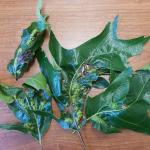
 Oak Leaf Blister Gall occurs most often on the leaves of red oak, as shown in these photos. (This sample was submitted to the UMass Plant Diagnostics Lab from Essex County, MA.) The cynipid gall wasp Melikaiella ostensackeni creates gall structures that appear as irregular and very hard protrusions on the upper leaf surface and corresponding lumpy, puckered areas on the lower surface. Slicing open the galls will reveal individual wasp larvae, pupae, or adults. As the galls “mature,” they turn from light green to brown and are peppered with wasp emergence holes as the adult wasps leave the galls. This typically occurs in mid-to-late summer. This species of gall wasp and the corresponding injury it causes to red oak is not significant for the overall health of the tree and does not require management. Other organisms may cause similar distortion to red oak leaves.
Oak Leaf Blister Gall occurs most often on the leaves of red oak, as shown in these photos. (This sample was submitted to the UMass Plant Diagnostics Lab from Essex County, MA.) The cynipid gall wasp Melikaiella ostensackeni creates gall structures that appear as irregular and very hard protrusions on the upper leaf surface and corresponding lumpy, puckered areas on the lower surface. Slicing open the galls will reveal individual wasp larvae, pupae, or adults. As the galls “mature,” they turn from light green to brown and are peppered with wasp emergence holes as the adult wasps leave the galls. This typically occurs in mid-to-late summer. This species of gall wasp and the corresponding injury it causes to red oak is not significant for the overall health of the tree and does not require management. Other organisms may cause similar distortion to red oak leaves. -

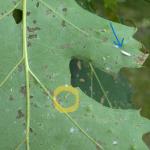
 Oak Skeletonizer populations have been noticeable in forested locations in the Williamsburg, MA area in recent years. A park tree in Ashfield, MA showed signs of the activity of this insect on 7/6/2024 as shown here. The oak skeletonizer is a native species of New England and elsewhere in the eastern United States and parts of Canada. Deciduous oaks and chestnut are hosts for this insect. Occasionally, this insect has a large outbreak population. For example, in 1971 in New York, trees were damaged by this insect by July and a second generation was found by September. In 1959 and 1960, two generations per year were observed in Michigan (Gibbons and Butcher, 1961).
Oak Skeletonizer populations have been noticeable in forested locations in the Williamsburg, MA area in recent years. A park tree in Ashfield, MA showed signs of the activity of this insect on 7/6/2024 as shown here. The oak skeletonizer is a native species of New England and elsewhere in the eastern United States and parts of Canada. Deciduous oaks and chestnut are hosts for this insect. Occasionally, this insect has a large outbreak population. For example, in 1971 in New York, trees were damaged by this insect by July and a second generation was found by September. In 1959 and 1960, two generations per year were observed in Michigan (Gibbons and Butcher, 1961).Foliage of the red oak group is skeletonized by this species. Leaves become translucent and eventually dry out. Heavily attacked foliage will appear lacey from the skeletonizing. Occasional outbreaks can cause damage over a large area, and repeated years of defoliation can cause a reduction in host plant growth. Occasionally, part of the tree crown may be killed by the activity of this insect. However, the oak skeletonizer is often found in low level, non-damaging populations and their presence can be tolerated.
Visually monitor for the activity of this insect in late May or early June (first generation). Look for skeletonized host plant leaves and eventually the characteristic white, ribbed cocoons. Trees can tolerate this native insect and often chemical management is not necessary.
- Oriental Beetle adults are active from mid-June through early August in Massachusetts. Adult activity occurs in the evening and at night, so the feeding they do on certain flowers (daisy, roses, phlox, and petunia) may not be seen by the observer.
- Pine Needle Scale can be a very serious pest of the needles of ornamental pines. Light infestations may go unnoticed and typically do not cause considerable damage. As a population increases, this scale insect feeds with piercing-sucking mouthparts to remove host plant fluids from the needles, causing them to eventually turn yellowish in color and possibly brown. Twigs and entire branches may eventually be killed. Lower branches typically die first. Depending upon geographic location, one or two generations of pine needle scales occur per year. If a second generation is present, second-generation crawlers are present by late July through September. Two generations per year occur in Massachusetts. More northerly locations may have a single generation per year.
- Pitch Mass Borer overwinters in the pitch mass found on the host plant. This insect tunnels beneath the bark, into the cambium. It may take up to two years for the pitch mass borer to mature. Pupation typically occurs by the end of May through June, in time for adult clearwing moth emergence in July and August.
- Privet Thrips are a non-native insect pest of privet, lilac, and ash. Thrips feed on the leaves of privet, causing them to appear gray in color made up of chlorotic spots. Immature thrips may be viewed with magnification on the undersides of host plant leaves. Several generations per year may be possible throughout the summer.
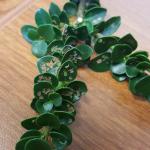
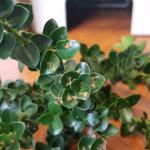 Redheaded Flea Beetle (Systena frontalis) has been identified as a native pest of nurseries in many locations in the eastern United States. Suspected redheaded flea beetle damage was seen on Ilex crenata 'Dwarf Pagoda' (Dwarf Pagoda Japanese holly) on 3/27/2024 that was purchased in Massachusetts but may have originated in NJ. While identification of this species of insect is uncertain based on host plant damage alone, it appears to be a reasonable and educated assumption. Redheaded flea beetles are known to feed on a wide variety of host plants. These include but are not limited to: cabbage, beans, beets, blueberries, and other agricultural crops as well as Physocarpus, Weigelia, Cornus, Forsythia, Itea, Hydrangea, and Ilex. Adult beetles are active and feed from approximately late-June to mid-September on the upper and lower leaf surfaces of their hosts. This can cause damage that looks like skeletonization and eventually holes in the leaves. Leaves appear covered in brown patches as in these photos. This damage was caused last season on this evergreen plant.
Redheaded Flea Beetle (Systena frontalis) has been identified as a native pest of nurseries in many locations in the eastern United States. Suspected redheaded flea beetle damage was seen on Ilex crenata 'Dwarf Pagoda' (Dwarf Pagoda Japanese holly) on 3/27/2024 that was purchased in Massachusetts but may have originated in NJ. While identification of this species of insect is uncertain based on host plant damage alone, it appears to be a reasonable and educated assumption. Redheaded flea beetles are known to feed on a wide variety of host plants. These include but are not limited to: cabbage, beans, beets, blueberries, and other agricultural crops as well as Physocarpus, Weigelia, Cornus, Forsythia, Itea, Hydrangea, and Ilex. Adult beetles are active and feed from approximately late-June to mid-September on the upper and lower leaf surfaces of their hosts. This can cause damage that looks like skeletonization and eventually holes in the leaves. Leaves appear covered in brown patches as in these photos. This damage was caused last season on this evergreen plant.- Redheaded Pine Sawfly larvae feed on the outside of host plant needles. This results in shriveled, browned, and straw-like needles that remain attached to the hosts. Older caterpillars are capable of eating the entire needle. Feeding began in the spring and early summer, and can sometimes be extensive by the fall.
- Rhododendron Borer is one of the smallest of the native clearwing moths. Adult emergence may begin in May and can last through July, depending upon local temperatures. Rhododendron are preferred host plants, with the larvae of this species boring into stems, often near the base of plants. Injured plant parts may be more attractive to these insects.
- Southern Pine Beetle has been trapped in Massachusetts since 2015. By 2022 and 2023, southern pine beetle has reached outbreak conditions in small areas of the state, killing pitch pine (Pinus rigida). (Particularly on Martha’s Vineyard and Nantucket islands in MA.) If you believe you have found infested pitch pine in Massachusetts, please report southern pine beetle using the Massachusetts Southern Pine Beetle Reporting Form from MA DCR.
- Spittle Bugs are insects that use piercing-sucking mouthparts to pierce plant stems and remove host plant fluids. The “spittle” or froth is created as the nymphs (immatures) pump air bubbles into fluid they secrete as a foamy substance while feeding. This foam keeps the insects moist and prevents desiccation, while also protecting them from natural enemies. Spittle bugs seldom, if ever, require management. But they can become very noticeable!
- Spruce Bud Scale overwinters as an immature scale on the undersides of host plant needles. Once spring temperatures warm, the dormant scales become active by late March and in April female spruce bud scales move to host plant twigs. Adult females are reddish-brown and round, and usually found at the base of new twig growth. In this location, they finish maturing and eggs are retained in the female spruce bud scale body cavity where, eventually, crawlers develop. These immature and mobile crawlers appear by approximately the beginning of June and may remain active through July. They then find suitable locations to settle and begin their feeding on the new growth of the plant. During this time, copious amounts of honeydew (sugary liquid excrement) may be excreted.
-
Tuliptree Aphid is a native North American insect that occurs wherever the tuliptree grows. Depending upon local temperatures, these aphids may be present from mid-June through early fall. There are several generations per year. The tuliptree aphid can cause reduced leaf size as a result of its feeding. These insects feed on their host plants with piercing-sucking mouthparts which they use to remove host plant fluids. Some leaves, especially those in the outer canopy, may turn brown or yellow and drop from infested trees prematurely.
The most significant impact these aphids can have is typically the resulting honeydew, or sugary liquid excrement, which may be present in excessive amounts and coat leaves and branches, leading to sooty mold growth. This honeydew may also make a mess of anything beneath the tree, including sidewalks and parked cars. Ants, bees, wasps, and flies may be attracted to and feed on the honeydew. Management is typically not necessary, as this insect does not significantly impact the overall health of its host.
- Tuliptree Scale is a soft scale pest of Liriodendron and Magnolia spp. among others. Second instar nymphs overwinter, begin feeding as temperatures warm in the spring, and mature into adults by the late spring/early summer.
- Twospotted Spider Mite season is under way as warm temperatures rise! Populations on many different deciduous and some coniferous hosts may rise from 363-618 GDD's and again from 1300-2000 GDD's. Twospotted spider mites prefer hot, dry conditions in the summer and fall. Population increases and subsequent plant damage can occur under these conditions. Using piercing-sucking mouthparts, mites feed primarily on the underside of host plant leaves and remove fluids. This feeding causes graying or yellowing of the leaves. Necrotic spots can also occur in advanced stages of leaf damage. This may lead to a stippled/bleached appearance of leaves; on occasion, complete defoliation due to spider mite activity is possible under high populations. Twospotted spider mites also create a fine webbing which can be found on infested plants.
Magnification is needed to visually detect twospotted spider mites. At least a 10-15X hand lens is required. The undersides of host plant leaves can be examined for the mites themselves or their shed or cast skins, as well as the fine webbing left behind by spider mites. However, it may be easier to view twospotted spider mites when a branch that is suspected to be infested is shaken or struck over a white piece of paper. See previous link for more details.
- Viburnum Leaf Beetle larvae may be found anywhere on the leaves and usually in groups. When young, larvae feed on the undersides of the leaves. As they grow larger, they may feed on the upper surface. Larval development may take approximately 8-10 weeks to complete and 3 larval instars are reported. Pupae are yellowish and are found in the soil beneath the host plant. Adults emerge around the middle of July and are brown, smaller than the largest larvae (approximately ¼ inch), and will also feed on the leaves. Adults are present in the landscape until the first hard frost.
- White Pine Aphid is a large, black, long-legged aphid found on twigs and small branches of eastern white pine. Search for aphids beginning in May and June. As the season progresses, honeydew and sooty mold may coat branches and needles of the host plant.
- White Prunicola Scale is an armored scale that has been on occasion found in samples submitted to the UMass Plant Diagnostics Laboratory. Trunks and branches primarily of Japanese flowering cherry, lilac, and privet are infested by the white prunicola scale. Feeding may reduce tree vigor and foliage may yellow or become sparse. Two generations may occur per year in New England, with eggs/crawlers in early June and again in early August. However, under warmer conditions, three generations per year are possible.
- White Spotted Pine Sawyer is a native longhorned beetle that is often confused for the invasive Asian longhorned beetle (see entry above). White spotted pine sawyer adults emerge in late May throughout July in MA. This insect completes its life cycle in weakened or recently dead conifers, particularly eastern white pine (Pinus strobus). It is not a significant pest. However, if you are unsure of the identification of a longhorned beetle, always take a photo and report it. You can report suspicious insects at the MA Department of Agricultural Resources Introduced Species Outreach Project Report a Pest Form.
- Yellow Poplar Weevil is also known as the sassafrass weevil, the magnolia leafminer, or the tulip tree leafminer. This insect, as all of these common names suggest, feeds on yellow poplar (tulip tree; Liriodendron tulipifera), sassafras (Sassafras albidum), magnolia (Magnolia spp.), as well as bay laurel (Laurus nobilis). Adult beetles lay eggs in the midribs of host plant leaves by May, after which the eggs hatch and larvae feed by creating blotch mines in the leaves. Larvae can be observed in May and June, and adults emerging to feed again by August, prior to overwintering in sheltered areas.
Beneficials/Non-Pests:
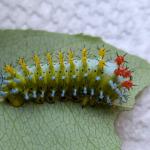
 Cecropia Moth Caterpillars are another example of one of our phenomenal native giant silk moths. These caterpillars are being reared indoors on a diet of black cherry (Prunus serotina). The cecropia moth is North America’s largest native moth, with adult wingspans over 6.2 inches! Found from the Rocky Mountains west and north to parts of Canada, this species is a sight to behold. Additional host plants include alder, birch, box elder, plum, apple, dogwood, and willow. These caterpillars will not cause significant damage to the overall health of these host plants and are spectacular wildlife that should be preserved!
Cecropia Moth Caterpillars are another example of one of our phenomenal native giant silk moths. These caterpillars are being reared indoors on a diet of black cherry (Prunus serotina). The cecropia moth is North America’s largest native moth, with adult wingspans over 6.2 inches! Found from the Rocky Mountains west and north to parts of Canada, this species is a sight to behold. Additional host plants include alder, birch, box elder, plum, apple, dogwood, and willow. These caterpillars will not cause significant damage to the overall health of these host plants and are spectacular wildlife that should be preserved!
Report by Tawny Simisky, Extension Entomologist, UMass Extension Landscape, Nursery & Urban Forestry Program
Landscape Weeds
For information about identification of weeds noted below, check out UMass Extension's Weed Herbarium.
English ivy (Hedera helix): In the last few weeks, I have received several inquiries about whether English ivy (Hedera helix) is invasive in Massachusetts. The Massachusetts Invasive Plant Advisory Committee (MIPAG) has not evaluated English ivy for invasiveness in Massachusetts. While this species is non-native, it would likely fall short of meeting some of the criteria that would make it designated as invasive, likely invasive, or potentially invasive. A full evaluation of this species would not likely show this plant to a) demonstrate the potential for rapid and widespread dispersion and establishment, b) have the potential to disperse over spatial gaps, and c) exist in high numbers in natural plant communities and minimally managed habitats. MIPAG defines an invasive plant as a non-native species that can spread into native or minimally managed plant systems in Massachusetts. These plants cause economic or environmental harm by developing self-sustaining populations and becoming dominant and/or disruptive to those systems. Early during the evaluation for plant species, a well-known nurseryman in Massachusetts coined the phrase “garden thug” which appropriately describes this plant specie's behavior in New England. Inquiries also ask about the best way to control English ivy. Management of a “garden thug” certainly can be justified in some situations. Initial research done in eastern Europe and repeated by Joe Neal at North Carolina State University showed that effective control was achieved with a postemergence application of glyphosate in the spring. Applications of a 41% glyphosate formulation at 4 to 5% should be applied when the new-season's growth is 3 to 5 inches long and has 3 to 5 leaves. At least 2 of 3 years of a spring application will likely be required for complete control.
Crabgrass (and other annual grassy weed) management in turf: Recent rainfall and very warm weather is moving crabgrass along and you need to bring your “A-Game.” Crabgrass is growing quickly in response to very warm weather. Postemergence herbicides will effectively manage crabgrass and routinely monitoring of turf areas is required to properly select the appropriate postemergence herbicide is needed. Determination of the predominant growth stage will dictate herbicide selection (see Table below).
Postemergence herbicides for crabgrass control |
||||||
|---|---|---|---|---|---|---|
|
Postemergence Herbicide |
Crabgrass Growth Stage LF = leaf, TL = tiller |
|||||
|
1- to 5-LF |
1-TL |
2-TL |
3-TL |
4-TL |
5-TL & up |
|
|
dithiopyr |
YES |
YES |
YES |
YES |
NO |
NO |
|
mesotrione |
YES |
YES |
YES |
YES |
NO |
NO |
|
quinclorac |
YES |
YES |
NO |
NO |
NO |
YES |
|
fenoxaprop |
YES |
YES |
NO |
NO |
NO |
NO |
Japanese knotweed (Fallopia japonica): Do not attempt to control Japanese knotweedm at this time, as herbicide applications are not effective in the early part of the growing season. In preparation for a late season herbicide application, cut or mow stands of knotweed to the ground in late May and early June. This practice will facilitate herbicide application by removing the dried stems from the previous year’s growth and will control plant height to make herbicide treatment easier in late summer. Removal of new top growth by early season mowing can reduce plant’s carbohydrate reserves. Since knotweed commonly grows in wet areas or near streams, rivers or wetlands, the management of this invasive plant may invoke 310 CMR 10.00: Massachusetts Wetlands Protection Act. 310 CMR 10.00 which regulates all activities in the resource areas identified in the act. Before any management activities can begin, the Conservation Commission in the municipality should be contacted to determine to what extent 310 CMR 10.00 might impact your project. Since we are quickly approaching the herbicide treatment window, now is the time to start working with the local Conservation Commission so that work can proceed in a timely manner.
Report by Randy Prostak, Weed Specialist, UMass Extension Landscape, Nursery, and Urban Forestry Program
Additional Resources
Pesticide License Exams by the MA Dept. of Agricultural Resources (MDAR) are now held online. For more information and how to register, go to: https://www.mass.gov/pesticide-examination-and-licensing.
To receive immediate notification when the next Landscape Message update is posted, join our e-mail list or follow us on Facebook.
For a complete listing of landscape, nursery, and urban forestry program upcoming events, see our calendar at https://ag.umass.edu/landscape/upcoming-events.
For commercial growers of greenhouse crops and flowers - Check out UMass Extension's Greenhouse Update website.
For professional turf managers - Check out our Turf Management Updates.
For home gardeners and garden retailers - Check out our home lawn and garden resources.
Diagnostic Services
UMass Laboratory Diagnoses Landscape and Turf Problems - The UMass Extension Plant Diagnostic Lab is available to serve commercial landscape contractors, turf managers, arborists, nurseries and other green industry professionals. It provides woody plant and turf disease analysis, woody plant and turf insect identification, turfgrass identification, weed identification, and offers a report of pest management strategies that are research based, economically sound and environmentally appropriate for the situation. Accurate diagnosis for a turf or landscape problem can often eliminate or reduce the need for pesticide use. For sampling procedures, detailed submission instructions and a list of fees, see the Plant Diagnostic Laboratory web site.
Soil and Plant Nutrient Testing - The University of Massachusetts Soil and Plant Nutrient Testing Laboratory is located on the campus of the University of Massachusetts at Amherst. Testing services are available to all. The lab provides test results and recommendations that lead to the wise and economical use of soils and soil amendments. For more information, including current turn-around times, visit the UMass Soil and Plant Nutrient Testing Laboratory web site. The lab is currently accepting orders for Routine Soil Analysis (including optional Organic Matter, Soluble Salts, and Nitrate testing), Particle Size Analysis, Pre-Sidedress Nitrate (PSNT), Total Sorbed Metals, and Soilless Media (no other types of soil analyses available at this time). Check for current turnaround time. Please plan for the fact that date of receipt in the lab is affected by weekends, holidays, shipping time, and time for UMass Campus Mail to deliver samples to the lab.
Tick Testing - The UMass Center for Agriculture, Food, and the Environment provides a list of potential tick identification and testing options at https://ag.umass.edu/resources/tick-testing-resources.
Acknowledgements: UMass Extension gratefully acknowledges the support of the following funding sources for the production of the Landscape Message –
- The Massachusetts Nursery and Landscape Association Fund
- The Massachusetts Department of Conservation and Recreation, Award #ISADCR28219926UMA24A
- Stakeholders like you! The Landscape Message is partially supported by educational program user fees.